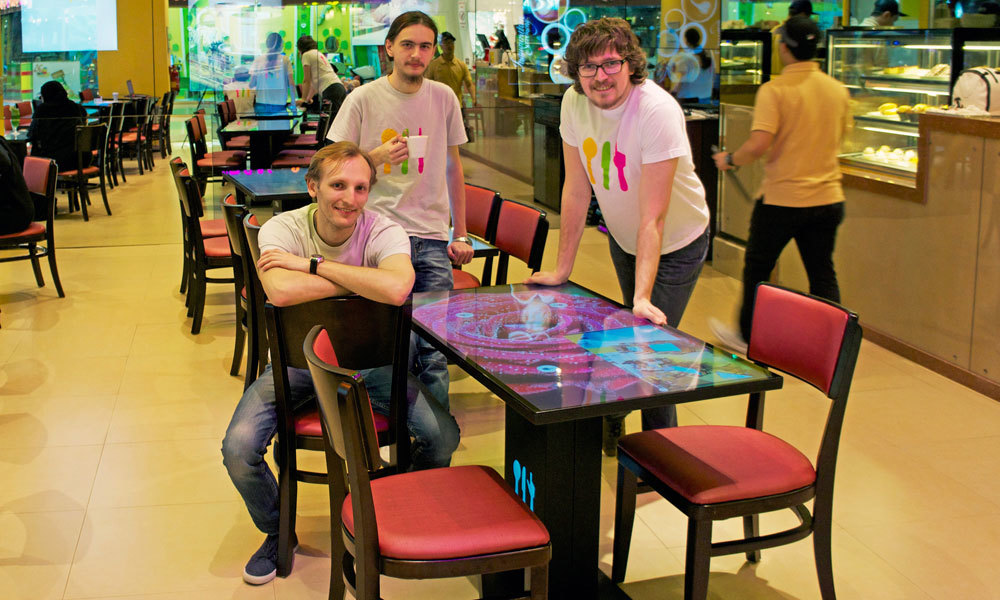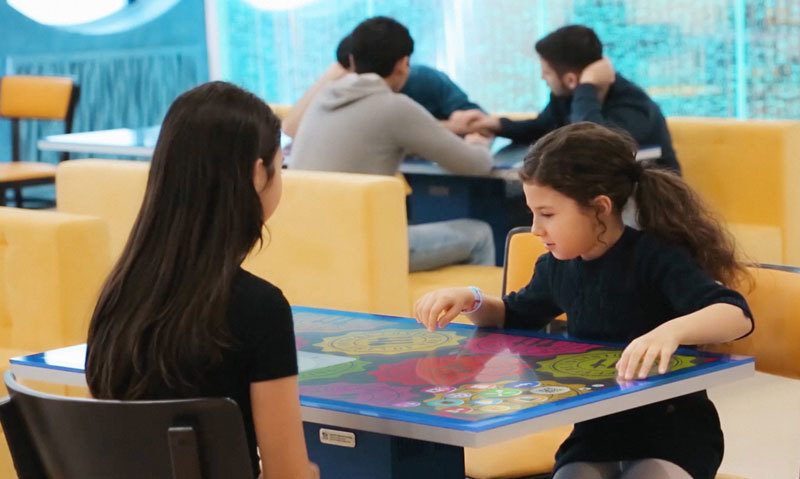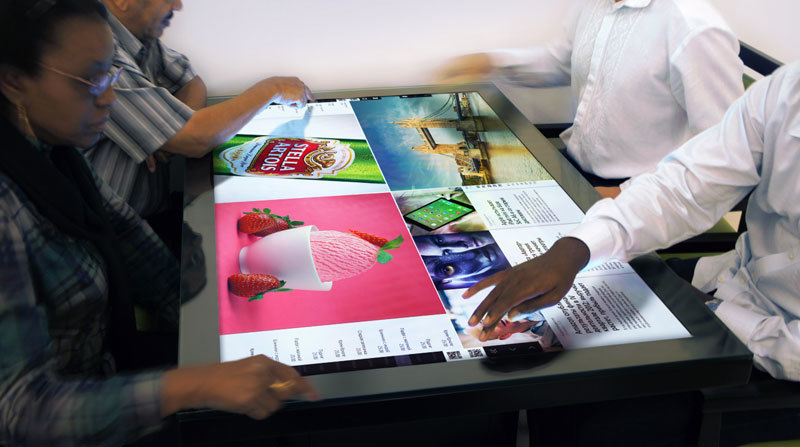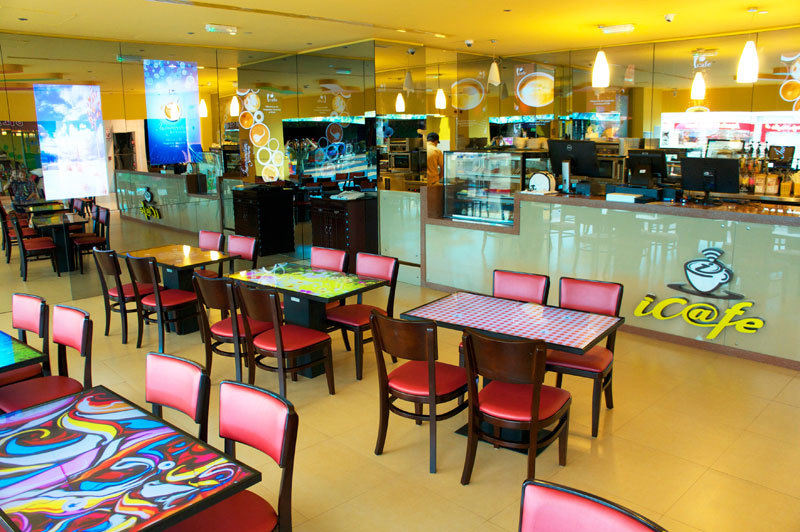About the UHD-resolution restaurant table and other interactive technologies from Kodisoft

Is it possible to come up with something fundamentally new in the arrangement of the restaurant? Only really radically new, and not what comes to mind in the first minute. We will also complicate the task: the innovation should delight visitors and be economically sound. If you consider this task hopelessly unsolvable, we suggest that you familiarize yourself with the experience of the Ukrainian company Kodisoft , which has developed an interactive restaurant infrastructure of a new generation, including a unique 4k resolution table-tablet.
About the project from the first person says its founder Dmitry Kostik.
How did you get the idea to do interactive technologies for restaurants?
The restaurant business is a fairly conservative market, and we wanted to change it. In fact, we were looking for the industry at the intersection with IT, where you can do something meaningful. So the choice fell on the restaurant industry. Well, then the creative process: they began to think what and how, they did research, did an audit, delved into the markets of different countries - they made decisions on tablets and smartphones, but the first, real pilot was done only 2 years later. It was a restaurant in Cyprus, where instead of touch sensors, Kinect was used above the table + ultrasound locators and TOF cameras - all this allowed to open the restaurant, study what people want, how to operate the restaurant and what processes it affects, as well as decide on the business model. Just think, in May of this year the restaurant will be 5 years old! And, by the way, we have never flown for service, and have not changed a single table. Stability!
So far you can be called a startup. In this case, you have not only software development, but already your own R & D. Tell us how it all began.
Yes, we are a startup who has not yet taken even a seed investment. Some time ago, even at the first projects, I realized that, while making a good product, you have to do everything yourself, from beginning to end - only this way you can control the whole process and not adapt to someone's hardware, or the housing, or the format, but the main thing is that, in addition to control, this provides freedom - and for me this is the main thing. The same thing happened with this project - when we started, touch screen technologies that would work through glass at least 8 mm thick did not exist, and I didn’t want to compromise a la IR frame or bottom projector and camera . It was decided that the surface should be solid glass, and the image should be bright and contrast - i.e. LCD panel, not a projector and be sure to have a good resolution. For the last 4 years we have been using only 4k UltraHD panels. Well, like this, step by step, for 4 years, we developed a new touch screen principle that can work through glass up to 25 mm and supports more than 1000 simultaneous touches, and even as a bonus, they were able to determine the pressing force and the shape of the object, and also brought reaction time up to 1.38 ms.

')
What are the components of your restaurant complex devices?
First of all, these are tables, a table is access to everything, this is furniture and the interface between the restaurant and the user, and entertainment, and the order and element of the joint interaction of visitors. In addition to the table, there is also network equipment, the local server is like a proxy, and the cloud. The manager has admin panel and content management, and the restaurant administrator has analytics and ERP.
And why a table, and not just a tablet. What is the table more convenient?
From the tablets we started - I remember, then there was a boom in them in restaurants with the USA - and look, what now? Almost all the companies closed down. And it's clear why, we then conducted a study and noticed that people take a tablet, make an order and clean it. And the table - it is always with you, it can not be postponed. And the experience is different. On the table, you can put together a puzzle, or share pictures, and the tablet is an individual thing. Well, after all: in a time when everyone has tablets and smartphones, another restaurant does not want to be taken in hand - it is usually in a rubber case, worn, covered in prints and people disdain.
Probably, all visitors are interested in the question: were there any cases that the table was broken? After all, it's still glass.
Rather, not visitors, but restaurateurs - all 100% ask it, and we tell all years that everything will be ok. But we decided to make a video to make it easier to show - (video see below). In fact, since the opening of the first restaurant, and this is almost 5 years, we have not replaced and repaired any table! I think this is proof of the quality of our product.
Tell me honestly, are there any disadvantages at the table too? What kind?
If we talk about the current performance, the main drawback is the price. Since we switched to 4k graphics at a frequency of 60Hz, we need the appropriate hardware, non-budget: this is a powerful processor, and two graphics slots, and high-speed PCI-E SSD, and a matrix controller that pulls it all at 36 GDS / s LVDS . But the most expensive element is the screen, the usual 4k matrix (like in TVs) cannot be taken, the structure of the pixel and the substrate is such that if you turn it into a horizontal plane, the pixels begin to drain after a couple of months - you probably saw a similar thing in the shopping center if someone wanted to save on the screen and instead of the industrial display they took the TV and turned it 90 degrees - the pixels flow out within half a year. And in the case of a table, this is a horizontal version, so the substrate should be on four sides, well, or change panels every 3 months ... That’s a tidy number.
What difficulties have you encountered in the design and production of an interactive table?
The most difficult thing is to ensure the feeling and usability of the table is not worse than what people used to expect from an iPad or iPhone. You must have seen a lot of touch-up kiosks, and, probably, every time you asked yourself questions - why is everything so slow? But we managed to solve this problem, and the reaction time is 4 times faster than on the iPad. As a bonus, I can show a technical review of our touch technology. Well, then the construction of its production. When you come up with a new technology, there are no ready ones for it. process, and you can not give production to outsourcing, because no one has the equipment for what you have invented and had to invent not only technology, but also then design machines and machines that produce the material and touch surface. But it is extremely fascinating.
As for the software part, there were no less challenges, primarily because of our desire to display the image in 4k resolution, and everything else just looks disgusting from a distance of 30 cm from the eyes to the surface of the table. It was in 2011 when 4k was not supported by any OS, except for Windows, even at the driver level, while with Windows 7 everything slowed down and did not want to work as it should. Therefore, we first began to rewrite the Windows composer, which is also DWM Core - what is now called Direct Composition in Windows 8.1 / 10. Since every second call falls on the kernel method call, we had to take Windows Embedded OS (now it's called Windows IoT). Well, they slowly wrote their composer and gradually added pieces of support for different platforms, first made support for DirectX applications, followed by WPF, rendering there, ultimately, on DirectX, then added HTML5 based on Chromium and at the end of Unity3D.
I remember how we got pre-release developer samples of Haswell processors and naively tried to launch a 4k interface on the integrated graphics with 12 applications running simultaneously. And you know what? We still launched! True, a more simplified version of the interface at 30Hz sweep, but still at 4k resolution. Now we are trying to port discrete graphics to the graphics integrated in Intel 6th generation processors and achieve 60Hz with the same 4k. It sounds like a challenge ... We are waiting for pre-release graphics samples Iris Pro 580 GTXe4.

Tell us more about the development of software components of the table. How deep was the original OS affected?
We did not have to rewrite the drivers. The problems of the current composer - he slows down at 4k resolution, but here you can optimize and put up with low FPS, but there is a second problem: Windows only draws windows on the desktop, and we need to turn them over and transform. So I had to rewrite most of the DWM and Composition Core - these are the two components that are responsible for windows and rendering. If in more detail, it is more than 20 thousand lines of a kind in C ++ and several patches of standard libraries, in one of which the drawing method is written in assembler and takes 11232 ASM commands.
Further acceleration is achieved by removing all unnecessary from the OS: shadows, buttons, headers, animations, and, most importantly, unnecessary redrawing of all windows, as Windows does by default. Left only the regions we need. There was also an idea to use undocumented features of Windows, but for ethical reasons and Microsoft licenses we have no right to do this.
As a result, at 4k resolution with running 8 applications (this is our minimum on the table), we got a stable 60FPS. If you just run the same on non-customized Windows, it will be about 18 FPS. In my opinion, this is very cool.
Where are the tables produced and what components are used in them? Why were they chosen?
We have a line in Kiev, Ukraine. Controllers, touch, processing - it's all our production, from the design of circuitry and printed circuit boards to assembly. From the side, we use only fans, fixtures, part of the mechanics and wires. Glass is also not ours, but, fortunately, there are a lot of glass factories near Kiev, so we outsource the work on glass. This is also a computer peripheral - well, it's full stuffing, and it is again justified by considerations of performance, so that everything flies, not delicately braked. Now it is an Intel 6th generation Core i7 processor, everything is spinning on it. We use its graphic subsystem not as graphics, but as computational cores on OpenCL - we have processing, processing of matrices and depth maps. Further, the SSD broom is very smart for access to 4k content without brakes, 8 GB of RAM and a couple of GTX970 video cards.

How is the issue of cooling the internal components of the table? Heat there, I think, stands out a lot. And also, like a table with energy consumption?
Part of the cooling is done with water, and then, after blowing the table legs out to the sides and sucking from the tabletop, we get natural air convection. As for consumption, all computer vendors are obsessed with energy efficiency, so the tables consume little - 230-260 watts.
What are your plans for opening new restaurants with your equipment?
Global. Here the market will prompt and direct. There are a number of contracts, but now I don’t want to disclose unfinished business and projects.
Source: https://habr.com/ru/post/280816/
All Articles